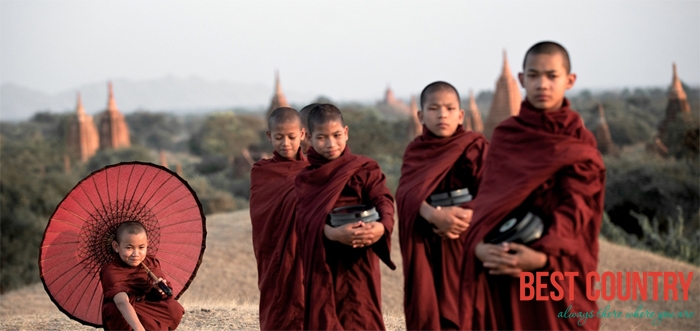Religion in Myanmar

Buddhism reached Myanmar around the beginning of the Christian era, mingling with Hinduism (also imported from India) and indigenous animism. The Pyu and Mon kingdoms of the first millennium were Buddhist, but the early Bamar peoples were animists.
According to traditional history, King Anawrahta of Bagan adopted Buddhism in 1056 and went to war with the Mon kingdom of Thaton in the south of the country in order to obtain the Buddhist Canon and learned monks.
The religious tradition created at this time, and which continues to the present day, is a syncretalist mix of what might be termed 'pure' Buddhism (of the Sri Lankan or Theravada school) with deep-rooted elements of the original animism or nat-worship and even strands of Hinduism and the Mahayana tradition of northern India.
Islam reached Myanmar at approximately the same time, but never gained a foothold outside the geographically isolated seaboard running from modern Bangladesh southwards to the delta of the Ayeyarwady (modern Rakhine, known previously to the British as Arakan, and an independent kingdom until the eighteenth century).
The colonial period saw a huge influx of Muslim (and Hindu) Indians into Yangon and other cities, and the majority of Yangon's many mosques and temples owe their origins to these immigrants.
Christianity was brought to Myanmar by European missionaries in the 19th century. It made little if any headway among Buddhists, but has been widely adopted by non-Buddhists such as the Karen and Kachin.
The Chinese contribution to Myanmar's religious mix has been slight, but several traditional Chinese temples were established in Yangon and other large cities in the nineteenth century when large-scale Chinese migration was encouraged by the British.
Since approximately 1990 this migration has resumed in huge numbers, but the modern Chinese immigrants seem to have little interest in religion.
Some more isolated indigenous peoples in the more inaccessible parts of the country still follow traditional animism.
The Roman Catholic Church, Myanmar Baptist Convention and the Assemblies of God of Myanmar are the largest Christian denominations in Myanmar.
Myanmar allows complete freedom of religious expression, and there appears to be no inter-religious tensions as such (although there are ethnic tensions, particularly between the dominant Bamar and the descendants of Indian migrants, which can find religious expression).
Nevertheless, the current regime's nationalistic policy of Bama san-gyin, which considers Buddhism a key element of Burmese-ness, does provide a systemic bias in favour of Buddhists in terms of preferment in the armed forces and other State structures.